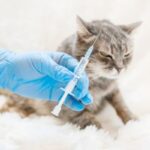Dogs can sustain injuries to their paws and continue to lick it or another area until the area becomes inflamed and hairless.
Lick granuloma
This condition is known as a lickgranuloma or acral-lick dermatitis. The exact cause of it is still unknown. It could be a self-soothing response to boredom or anxiety. It could also be a result of an injury, sore, arthritis, or joint pain. This can then become a sort of chronic obsession.
Atopic dermatitis
Atopic dermatitis can also be the root cause. This is an inflammatory chronic skin condition that results from hypersensitivity to one or more substances in our environment. This is the second most common allergy in dogs. The symptoms typically appear in dogs between the ages of one and five years.
Atopic dermatitis can be triggered by a variety of substances called allergens. These allergens are often the same ones that cause allergic reactions in humans, such as hay fever. They can also be harmless in the environment like grass, moldspores, and house dust mites. Itching is one of the most common signs. Itchy skin all over or in certain areas can occur, such as the ears, feet, and face.
Diagnosing skin disease in dogs
A veterinarian will perform a physical exam and clinical observation to diagnose atopic dermatitis. A full body examination for mites, fleas and lice should be done to rule out parasites. To rule out other underlying conditions, such as low thyroid levels, a blood panel, urine test, and fecal test should be performed.
An “elimination diet”, which is a suitable food regimen, can be used to rule out allergies to specific foods or proteins. Your veterinarian will need to review your complete medical history. This includes a detailed history of all foods and treats that your pet has had, as well as table scraps and chew toys containing food flavors. A new protein and carbohydrate source will be added to an elimination diet. This means that your dog won’t have eaten the same protein or carbohydrate in the past. For the specified time, you must only feed the prescribed diet.
Allergy testing might be recommended if your vet suspects that the dog has atopic dermatitis. There are two types. Intradermal allergy testing works in the same way as it does for humans. Under sedation, small amounts of about 60 allergens are injected into the skin of one side of the dog’s head after clipping the hair. Although this is often called the “gold standard”, it does not guarantee 100% reliability, particularly when reactions are weak.
Blood allergy testing is the second type. This test measures the amount of antibodies your pet has developed against specific allergens. This test can be inaccurate so it is best to talk with your vet about the pros and cons of each type.
Atopic Dermatitis Treatment
Your vet will be able to prescribe a treatment plan once a diagnosis is made. Atopic dermatitis is something that can be managed, but not necessarily treated. Some dogs may respond better to certain medications than others. You will need to consult your vet to help you determine the best treatment plan. Depending on the severity of your dog’s response, you can use these treatments alone or together.
Anti-inflammatory medication
Itching can be reduced by using Atopica, Apoquel, fatty acids supplements, prednisone, or other medications like antihistamines, such as prednisone, Atopica, and fatty acid supplement, Atopica. Apoquel, Atopica and fatty acid supplements are FDA-approved nonsteroidal medications for the treatment of canine atopic dermatologitis.
Apoquel’s long-term effects have not been fully studied since it was approved only recently. Most common side effects include nausea, vomiting, diarrhea, lethargy and a lack of appetite. Suppressing the immune system can lead to increased susceptibility to infections or skin disorders. There is also the possibility that certain types of cancer may occur. These side effects are rare but should be discussed with your doctor.
Topical therapy
You can use medicated shampoos or conditioners to help. The allergens may be removed by bathing. Additionally, the medicated ingredients can reduce itching and prevent secondary infections. To reduce itching, use lukewarm warm water.
Antibacterial and antifungal medication
Recurrent yeast and bacterial infections are common in dogs with atopic dermatology. These infections may require antifungal and antibiotic medication. Antibacterial and antifungal shampoos can also be used to treat and prevent infection.
Hypoallergenic diets can sometimes be combined with the other therapies, if multiple allergies (eating and environmental) are detected.






